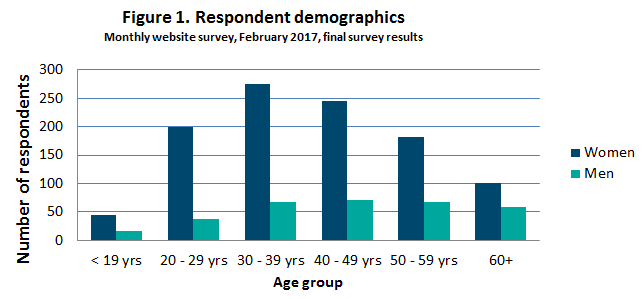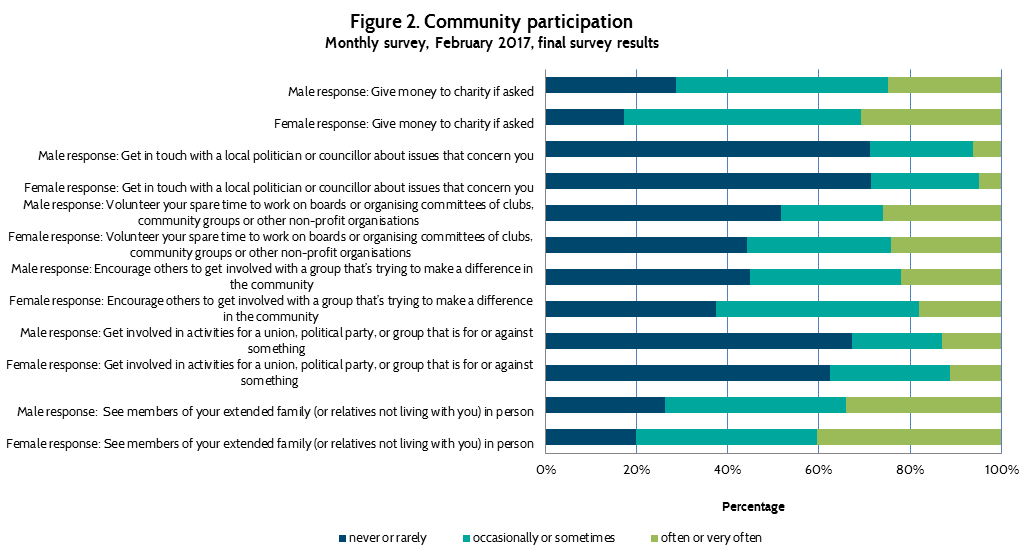Introduction
Relationships Australia has previously explored different ways people participate socially in their community with a view to understanding how community participation impacts on positive wellbeing. This interest has been informed by various national and international studies that have confirmed economic and social participation are essential to the success and wellbeing of people, with high levels of participation linked to better physical and mental wellbeing.
A study by Berry, Rodgers and Dear (2007), for example, identified that while people may choose to participate in their community in many ways and at different levels, regular involvement in certain activities are especially beneficial, in particular those pursuits that are characterised by personal involvement, initiative and effort.
In 2014, Relationships Australia’s monthly online survey asked about involvement in six activities associated with wellbeing. The focus of Relationships Australia’s February’s 2017 online survey was to find out whether visitors to our website are active participators in a number of other activities that have been found to be protective against the onset of physical and mental disorders. The community participation questions selected for February’s online survey were adapted from the community participation scale included in the Household Income and Labour Dynamics Survey of Australia.
Previous research finds that…
- Community participation activities such as taking an active interest in current affairs; regularly socialising with household members, friends, extended family and neighbours; and taking part in organised community activities have been associated with improved wellbeing.
- Happier people give more and giving also leads to increased happiness.
- People who volunteer have lower mortality rates, greater functional ability, and lower rates of depression later in life than those who do not volunteer.
- Money is associated with wellbeing because having enough money improves living conditions and increases social status. However, happiness only increases with income to a point. A range of studies have shown that it is the quality of our personal relationships, not income that has the greatest effect on our state of wellbeing.
- Believing that money is the key to happiness can also harm a person’s wellbeing. For example, a person who chooses to work a lot of overtime misses out on time with family, friends and leisure pursuits.
Results
More than 1,400 people responded to the Relationships Australia online survey in February 2017. Around three-quarters of survey respondents (77%) identified as female, with more females than males responding in every age group (see Figure 1 below). Just under eighty-five per cent of survey respondents were aged between 20‑59 years, and almost 40 per cent of respondents comprised women aged between 30-49 years (inclusive).
As for previous surveys, the demographic profile of survey respondents remains consistent with our experience of the groups of people that would be accessing the Relationships Australia website.

Men and women reported higher levels of participation when asked about seeing members of their extended family not living with them and giving money to charity when asked (Figure 2). Forty per cent of women, and one-third (34%) of men reported that they often or very often saw members of their extended family, while around one-third (31%) of women and one-quarter (25%) of men reported that they often or very often gave money to charity if asked.
There were no significant differences in the reports of men and women when they were asked whether they get involved in activities for a union, political party, or group that is for or against something, or whether they get in touch with a local politician or councillor about issues that concern them. Around two‑thirds of survey respondents reported that they never or rarely undertook these activities.
Around one-fifth (18%) of women and men (22%) responding to the survey reported that they often or very often encouraged others to get involved with a group that’s trying to make a difference in the community. Slightly more women (24%) and men (26%) reported that they often or very often volunteered their own spare time to work on boards or organising committees of clubs, community groups or other non-profit organisations

References
Anik, L, Aknin, L, Norton, M, & Dunn, E. (2009). The Benefits (and Costs) of Self-Interested Charitable Behaviour, Working paper 10/012, available at http://www.hbs.edu/faculty/Publication%20Files/10-012.pdf
Australian Bureau of Statistics (2008). Australian Social Trends, cat. no. 4102.0
Berry, H.L. & Shipley, M. (2009). Longing to belong: personal social capital and psychological distress in an Australian coastal region. Social Policy Research Paper No. 39. Canberra.
Eime, R, Harvey, J, Craike, M, Symons, C, and Payne W. (2013). Family support and ease of access link socio-economic status and sports club membership in adolescent girls: a mediation study, International Journal of Behavioural Nutrition and Physical Activity 2013, 10:50 http://www.ijbnpa.org/content/10/1/50
Wood, S, Bellis, M, Kelly, D, Hughes, K, Eckley, L and Chadborn, N. (2012). Use and perceptions of parks in Merseyside & Manchester